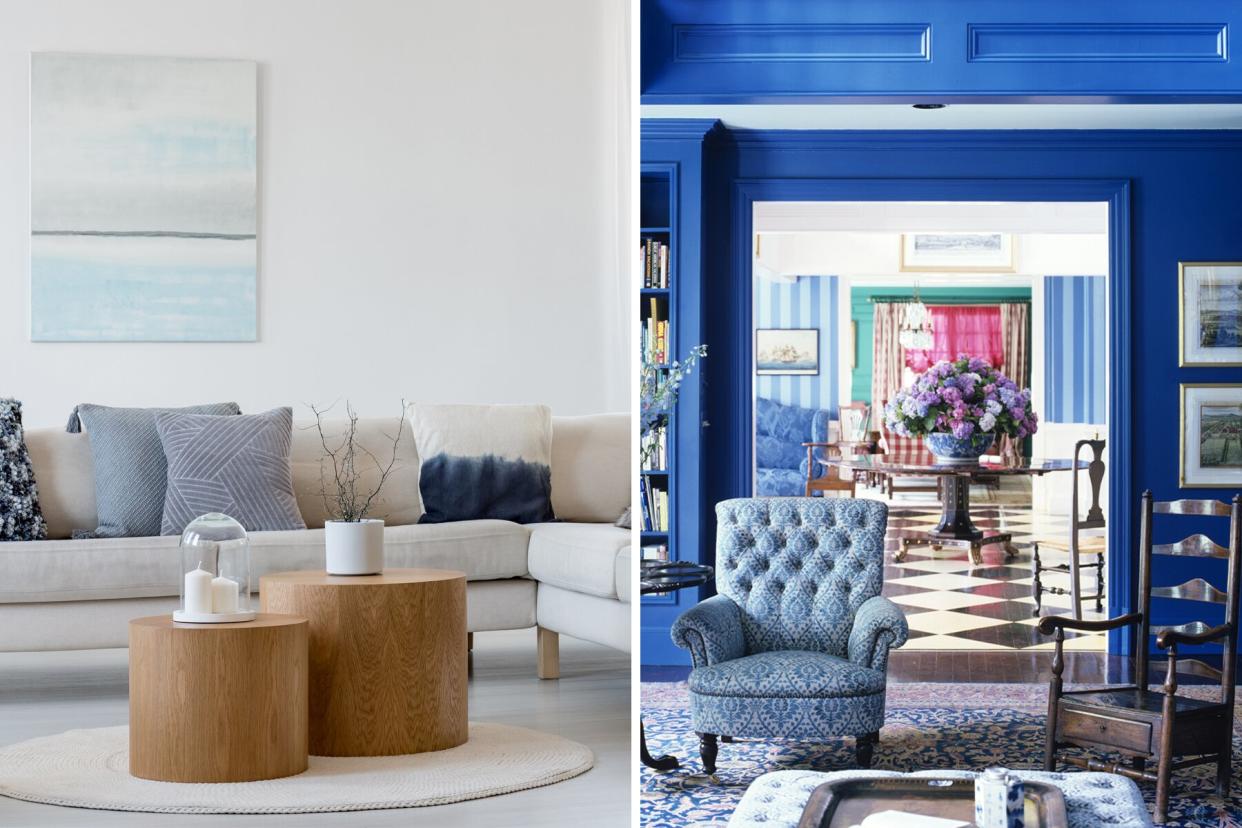Both Minimalism and Maximalism Are Trending—Interior Designers Explain the Surprising Coexistence

Pieter Estersohn / GETTY IMAGES
TABLE OF CONTENTS
On This Page
Minimalism
Maximalism
How to Use Both Styles
If you've been paying attention to interior design trends, you might have noticed an interesting phenomenon popping up in magazines, TV shows, and your social scroll: the confluence of both minimalism and maximalism. While these differing aesthetic approaches mostly thrive independently of each other, there are those who successfully embrace the tenets of both under a singular roof. Perhaps most interesting of all is that, somehow, it just works.
For a better understanding of how minimalism and maximalism are enjoying a simultaneous heyday, we took a moment to poke our heads into both worlds.
Related: What Is Scandinavian Design? Here's Why This Style Continues to Stand the Test of Time

GETTY IMAGES
Minimalism: A Thoughtful Edit
In the truest sense of the word, minimalism embraces simplicity. It's not necessarily focused on a "less is more" approach; instead, it calls on intentional design that accentuates the architectural form and function of a space.
"While minimalism might seem easy to achieve, it's anything but," says interior designer Benjamin Johnston. "Every item has a purpose, clutter is generally nonexistent, and you'll see a lot of sculptural furniture and holistic forms as impactful means for showcasing creativity. There is [also] an enhanced focus on natural light and a monochromatic palette, and when you do add in color, it's very deliberate."
Minimalism in History
Minimalism doesn't have a singular root—it has origins that span across the globe and throughout history. It's attributed in part to serenity-inducing Japanese zen gardens, the Dutch De Stijl movement, and nature-forward Scandinavian design (which has become synonymous with simplified mid-century modern design).
"It also came about as a response to the superfluous nature of Victorian architecture. In the post-war era, glass, steel, and concrete were new fixtures in the building process, so minimalism was very much entangled in the Bauhaus and modernism movements," says Johnston. "Of course, each new generation seems to resist its predecessors, but the evolution of design also reflects where the world was during any given time period."
Modern Minimalism
Today's adaptation of minimalism also weaves in principles of sustainability and reduced consumerism, says Christina Simon, principal designer of Ashby Collective. She notes that it's transcended into not just an aesthetic, but a mindset, in which you gather only what you need and focus on well-made, thoughtful, everlasting construction. In that sense, it's a direct response—a sweeping pendulum swing, if you will—against mass, fast-paced consumerism.

Pernilla Hed / GETTY IMAGES
Maximalism: More Is More
Maximalism might be a new word in today's lexicon, but we've seen iterations of this approach throughout history. It was the very essence of Baroque design, with its gilded walls and flourished architecture, and—as mentioned above—was the modus operandi of Victorian design, which embraced eclectic knick-knack collections and utter opulence.
Maximalism in History
"The British were known for their layers upon layers of patterned fabrics, wallpapers, and drapery all combined with family artifacts, objects, and collections," says Simon, who points to French interpretations, as well. "Versailles, in my opinion, would be an obvious example of maximalism through its elaborate fanfare, details and pattern, collections, and fuss."
Modern Maximalism
Modern iconic examples of maximalism include Hollywood Regency, says interior designer Jess Klein, along with the layering of color and palettes that defined the 1970s. Of course, we're seeing that same "more is more" approach re-emerge today—which coincides with the '70s revival happening right now. "Today's maximalism is less about status and more about personal style," says Johnston. "There's thoughtful clutter, sprawling gallery walls, and oftentimes vintage or antique furniture to lend a high-low mix. What truly makes maximalism work is the ability to tell a design story."
This can be achieved through repeating patterns, says Johnston. Think pleated lampshades featuring the same fabric as your throw pillows, wall art that's displayed in a salon style, and leaning on a color palette of three to five hues that's at once vibrant and carefully edited.

Andreas von Einsiedel / GETTY IMAGES
The Harmonious Convergence of Both Aesthetics
We tend to categorize varying design aesthetics into their own isolated buckets—sometimes even "pitting" two channels against each other in a "this versus that" square-off. Maximalism and minimalism are the perfect example of this. When we reframe both as coexisting on a spectrum, though, it's easier to understand how both can easily coincide.
In that sense, it's less about a flip-flop between which aesthetic will come out on top—and more about finding ways to embrace both in a way that speaks to your personal style. "In our work, we're hearing from clients that they want to see less clutter and visual stimulation in their homes, but still enjoy the comfort of being surrounded by their belongings. I think that's where this mash-up of minimalism and maximalism is happening," says Klein.
Simon agrees. "Playing between minimalism and maximalism is actually one of the ways you can continually make your home feel fresh and designers use this all the time," she says.
How to Bring Both Styles Into Your Home
Try a wild, colorful patterned fabric on a very slick, modern-lined chair, utilize modern cabinetry as a means to display an eclectic collection, or make a maximalist splash in the powder room while keeping other areas of the home more streamlined. It's perhaps this very tension created between both worlds that makes for good, interesting design.
Ultimately, our homes are expressions of ourselves versus perfect renditions of today's biggest trends. These are expressions that take years to develop and are forever in flux as we're influenced by and drawn to different things. At the end of the day, prioritizing what truly matters to you is one of the best ways that you can create a home that feels like a functional and authentic sanctuary—whether it's sleek and streamlined, colorful and trinket-filled, or a strategic mix of both.

